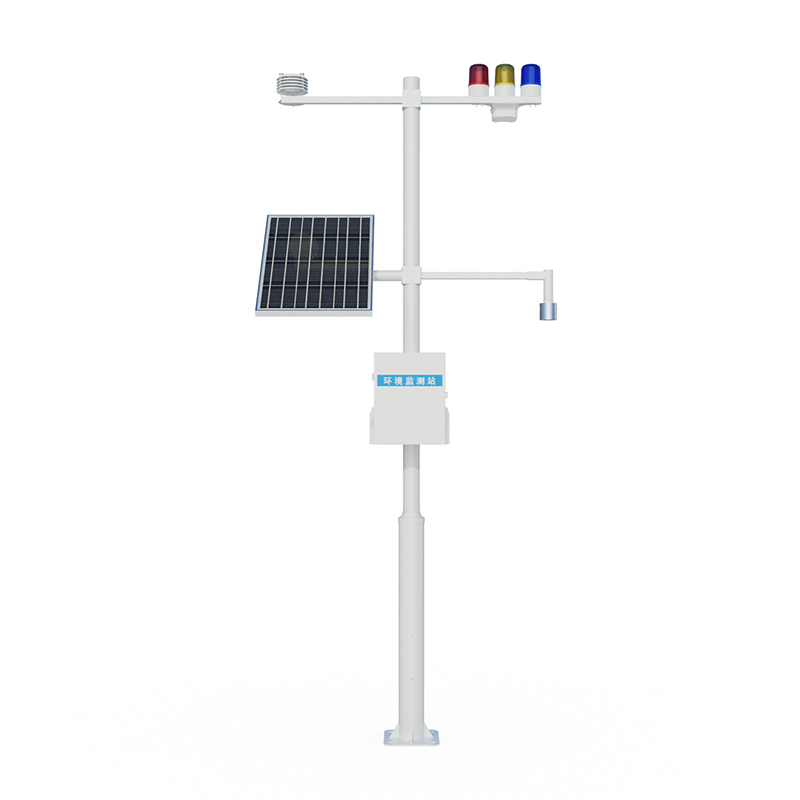Meteorological environment monitoring equipment supplier
Insist on doing high-precision customer favorite technology products

1.Introduction to Lightning Warning System
Lightning Warning System is used to detect and warn short-term thunderstorms in important places to reduce the impact and damage caused by thunderstorms.Lightning Warning System is a fully digital electric field detection and lightning early warning platform.Its core electric field detection structure is based on the principle of charge induction and is developed using MEMS (micro-electromechanical system) technology.It does not wear and moveable mechanical components such as motors.It has outstanding advantages such as small size, low power consumption, high reliability, and easy integration.The system uses electric field differential combined with threshold threshold optimization lightning warning algorithm.Compared with the conventional threshold threshold method, it is highly likely to avoid false alarm problems caused by human interference (rainy days/strong winds/snow days/dust), further improving the accuracy of early warning.Lightning Warning System is accurate, convenient for networking and easy to install, and is mainly aimed at the application needs of atmospheric electric field detection and local short-term lightning warning in the fields of aerospace defense, meteorology, petroleum and petrochemical, power grid, scenic spots, mines, oil depots, military and other fields.
2.Lightning Warning System product composition
1.Lightning warning detector
2.Data processing host
3.Solar power supply system
4.Anti-direct lightning system
5.Surge system
6.Grounding system
7.Air temperature, humidity, and atmospheric pressure sensors
8.Acoustic and optical alarm level 3
9.Cloud data query and real-time display
3.Product features of Lightning Warning System
1.Users can connect the Lightning Warning System probe to the cloud server to achieve the purpose of remote monitoring.
2.Through the analysis of data, make more accurate judgments on the intensity and polarity changes of the thunder cloud electrostatic field
3.This system can be connected to the sound and light alarm system
4.The system software has complete network transmission functions; the data transmission completely follows the network protocol
4.Lightning Warning System Technical Parameters
| Device name | Lightning Warning System |
| Electric field measurement range | -100kV/m~100kV/m |
| Resolution | 0.1V/m |
| Accuracy | ±0.001%FS |
| Detection distance (radius) | 15KM |
| The weight of the whole machine | 36KG |
| Sensor weight | 710g |
| Input voltage | DC12V |
| Power consumption | 12VDC (2W@12V) (System) |
| size | 105*78mm (sensor); 3m (upper rod bracket) |
| Operating temperature | -10℃~60℃ (sensor); -40℃~80℃ (controller) |
| Deployment location (indoor/outdoor) | outdoor |
| Listing height | 2.1m (bracket) (sensor installation height 1.9m) |
| Management interface type | RS485-Modbus-RTU (sensor); RS485-json/RS485-Modbus-RTU (controller) |
| Alarm linkage (control) function | Level 3 early warning |
| Number and type of data interfaces | 3 aviation sockets, 1.Power supply, 2.RS485-json, 3.RS485-Modbus-RTU |
| GPRS data traffic requirements | 100M/month |
| Outgoing data frequency | 60s |
| Outbound data communication protocol (broadcast) | json |
5.Precautions for installing Lightning Warning System
1.Lightning warning probe should be installed on sunny days
2.The lightning warning probe should be installed outdoors without any obstruction and surrounding unobstructed objects.
3.Do not install it at the generator exhaust outlet, beside the telephone pole or under the high-voltage line.
4.Under abnormal circumstances, when protruding on the ground, close to the antenna pole or other equipment, the field strength and its test data may be disturbed.
5.Under wired mode, the wiring distance between the outdoor electric field meter probe and the indoor main unit should not exceed 100 meters.
6.The equipment should have good grounding when in use
7.For more details, please consult our company
8.If there is any parameter update without notice, the right to technical interpretation belongs to our company.
6.Lightning Warning System installation steps
1.Remove the full set of Lightning Warning System from the box
2.Fix the bracket to the designated installation position and fix it with bolts
3.Connect the flash point on the top of the lightning rod (optional) to the grounding wire, and the other end grounding wire is introduced from the inside of the bracket and out from the bottom hole of the bracket.After the grounding electrode and other grounding devices are installed, connect the lightning rod grounding wire.
4.Introduce the wires of the atmospheric electric field meter probe and the temperature and humidity sensor from the inside of the bracket, lead out from the hole in the middle of the bracket, and connect it to the main control box.There is an expansion box in the main control box.
5.Fix the solar panel to the bracket and connect the solar energy wire to the photovoltaic controller according to the color
7.Connect the battery to the photovoltaic controller
8.Connect the control line of the three-color sound and light alarm light to the alarm control module one by one according to the line color.
9.Contact after-sales service through the equipment number on the equipment box to obtain the login account
10.Open the computer and log in to the cloud platform to view data through the browser (Google or Huawei browser)